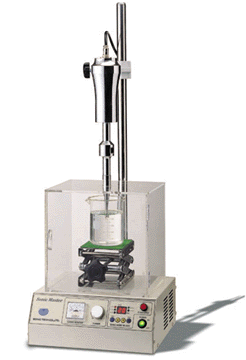
1. Configuration of the ultrasonic disperser
This product generates ultrasonic waves by means of an ultrasonic oscillator and a piezo-electric ceramic device that converts electric energy into mechanical vibration energy applying an inverse piezo-electric effect. It is composed of an oscillator, booster, horn, and ultrasonic oscillation unit. The booster and horn are attached to the oscillator in order to increase the amplitude of the generated ultrasonic waves, and the ultrasonic oscillation unit drives these generated ultrasonic waves.
2. Functions of the Ultrasonic Disperser
This product is operated based on the dynamic function of ultrasonic waves generated by the oscillator and the horn. This dynamic function can be achieved by the cavitational bubbles that are generated when the ultrasonic waves, generated by oscillator and horn, are irradiated to an aqueous solution. When the ultrasonic waves are irradiated to an aqueous solution, the temperature and pressure of the cavitational bubbles are very high. And when the bubbles grow and burst, some shock waves with high temperatures and high pressure are generated. These waves are used as an energy source for mixing or dispersing different types of liquid, which otherwise cannot be mixed.
When ultrasonic waves are generated at the border of two different types of liquids that usually cannot be mixed, i.e. mercury and water, or water and oil, an emulsified compound of liquid can be produced. The vibrations of ultrasonic waves dissolve a type of liquid into minute particles, and mix it with other type of liquid. The emulsified compound produced by ultrasonic waves maintain its even form relatively for a long period of time compared to one produced by mechanical mixing. This emulsified compound can be applied to the manufacture of various products including cosmetics, the emulsification of film, mayonnaise, chocolate, and ointment. In addition, it is applied to destruct cells or cell organs, to form stable emulsified substances, and to catalyze physical and chemical reactions. Also, it is applied to the extraction of certain substances and to the Degar action in some types of specimen. Since an even mixing and homogenization of specimen can be achieved using this emulsified compound, various other tasks can be executed including grinding tablets for the purpose of conducting a solubility test and concentrated cleaning of such complicated parts as nozzles or filters.
3. Uses of the Ultrasonic Disperser
Ultrasonic waves applied to this product hae a low frequency of about 15-30kHz and a high output. Most dispersers are designed to require, depending on their uses, the output of about 100~4,000W and the frequency 20~28kHz.
The ultrasonic Disperser is used in various fields including chemistry, genetic engineering, pharmaceutical chemistry, environmental engineering, and in the foods industry. Ultrasonic waves are widely used in the field of analytical chemistry for such purposes as breaking chemical bonds, forming free reactor, making macromolecules, breaking the bond of macromolecule with long chains, catalyzing of physical, chemical, and electric chemical reactions, and in manufacturing catalysis. Using the ultrasonic, one can lower the reaction temperature, shorten the reaction time, and reduce the cost in the above-mentioned chemical experiments.
In addition, ultrasonic waves are used in separating proteins or enzymes from cells. Breaking cells using ultrasonic waves are processed very quickly and without any error. Also, powerful ultrasonic waves are used for many different purposes including the acceleration of cell activation, sterilization, and as an auxiliary device for extraction, freezing, emulsification, filtering, and drying.
The mechanism of ultrasonic cavitation, which occurs when ultrasonic waves are irradiated to an aqueous solution, is composed of three stages including nuclear formation, the growing of bubbles, and explosion of matured bubbles. In this process, the temperature and the pressure inside the bubbles are as high as 4,500℃ and hundreds of atm, respectively. Also, at the moment the bubbles explode, some shock waves are companied, of which the temperature and pressure are about 1,500℃ and hundreds of atm, respectively. These high temperatures and pressures inside the bubbles combined with the shock waves cause such actions as the breakage and emulsification of cells.
4. Characteristics
- Installed with various types' horns and probes
- Even and stable compounds
- Vibration of Amplitude
- Excellent stability against temperature or load
- Enable to provide the horns and probes made of alloys titanium
- Enable to provide any special forms of probes according to the customers' orders.
|

 This product is used for mixing or dispersing different types of liquid that cannot be mixed by using ultrasonic waves.
This product is used for mixing or dispersing different types of liquid that cannot be mixed by using ultrasonic waves.